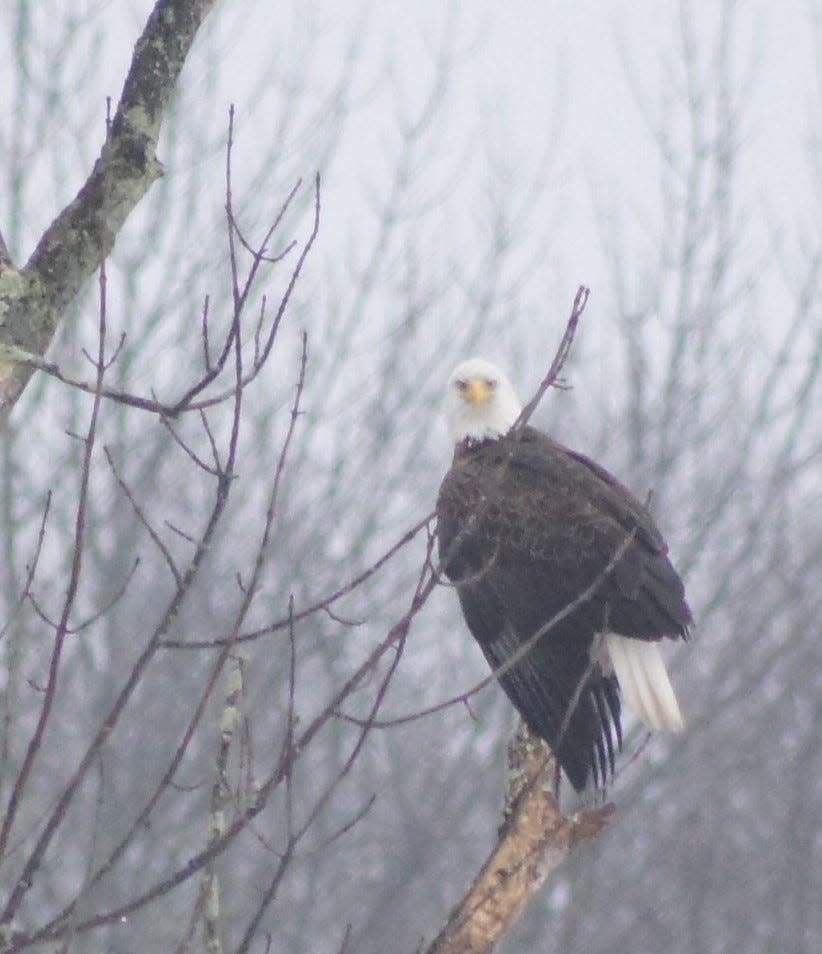Here are the latest stats on Sussex County's bald eagle population
Observers watched as 16 eaglets flew away from eight of the 12 bald eagle nests monitored in Sussex County during the late winter and early spring nesting season last year.
Each year, volunteers with the state Division of Fish and Wildlife take on the task of observing known eagle nests across the state, recording the date at which incubation of eggs begins, date of hatching and the number of eagles which fledged and left the nest. Also recorded is a "date of failure" if known.
With plenty of streams and lakes, as well as preserved parks, forests and open space, Sussex County has the highest number of known eagle nests in northern New Jersey. The most plentiful nests are in the southwestern portion of the state along the shores of Delaware Bay and eastward toward the Atlantic Ocean.
Overall for the state, volunteers monitored 267 known eagle nest sites and reported activity at 250 of them, with a known outcome at 236.
The observers noted there were 17 territorial pairs − which didn't produce young − and 197 "successful" nests which had at least one eaglet fly away from the nest.

In all, there was a total of 335 fledged eaglets, with nine nests producing three fledglings each. Each of Sussex County's successful nests had two fledglings.
Bald eagles mate for life. Should one of a pair die, the survivor will take another another adult eagle, but often the new pair will build a new nest.
Sometimes, that new pair/new nest will produce fledglings, such as one along the Paulinskill in Stillwater last year. Another known nest, located in the Hyper Humus area just north of Newton, had a pair of eagles, which exhibited "terrirorial" behaviour, but no sign of incubation.
An eagle pair, while going their own way after raising fledglings in one season, will return to the same nest the following year. Should one of the pair not show up, the survivor may pair with a new eagle, sometimes taking over the same nest, but also build a new nest.
Should a nest be destroyed, the pair will build a new one in the same area. At the beginning of each breeding season, the pair will add on to the previous year's nest. The average nest is about 4 to 6 feet in diameter and 3 feet deep.
In one case noted in the 2022 report, a storm destroyed a nest with one eaglet discovered on the ground. The chick was re-nested in early June and did not fledge until July 7, several weeks later than normal.
The state report locates nests on Tocks Island and Poxno Island, both in the Delaware River in the Warren County part of the Delaware Water Gap National Recreation Area, and one near Dingmans Bridge in Sandyston, however there is no listing of any other bald eagle nest in New Jersey's part of the park.
A park spokesperson said there is no effort to monitor bald eagle nests within the park's boundaries, but noted that NPS regulations advise keeping at least 1,000 feet from a known nest. The park also does not produce a list of known eagle nests within the recreation area.
For subscribersChatham schools file suit against 'ruthless' social media giants for harm to students
New Jersey environmental law also establishes the same 1,000-foot distance regulations and prohibits disturbance of any eagle nest. Most nests are not identified, but some have signs or other markings defining the "do not enter" area. As an example, bouys are placed in Little Swartswood Lakes marking a known nest in a tree on the shore.
While the bald eagle has been a symbol of the United States from the beginning of the country, there were no federal or state laws protecting the birds, among the largest in North America, because eagles were thought to be predators of game and farm animals.
Indiscriminate killing of the birds, as well as the development of the insecticide known as DDT, decimated the eagle population.
At that point, the Endangered and Nongame Species program began an effort to restore the population, both by strict regulations and efforts to bring in eaglets, raise them and release them into the wild.
New Jersey's efforts, which are mirrored by several states, have resulted in the birds, once listed as an endangered species, being taken off the federal list in 2007. However, there are still state and federal regulations which protect nest and roosting sites for bald eagles.
This article originally appeared on New Jersey Herald: Sussex County NJ bald eagle population: By the numbers

